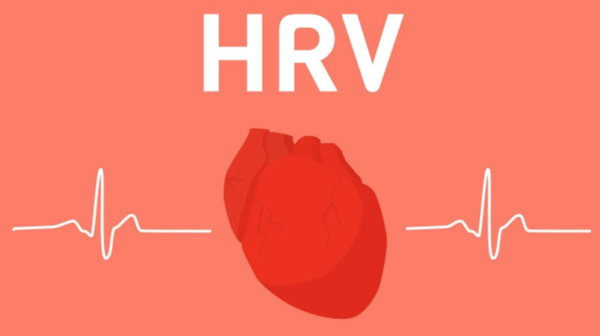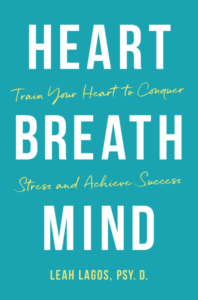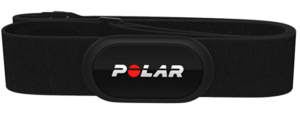
There is now another way to look at stress. We used to always think it was centered in the brain. But now we know that when it comes to stress, there is a specific relationship between the brain and the heart.
It makes sense! How often have you had a clear mind when your heart was beating wildly? And when your palms were beating profusely? This is because your stress is actually inside of your body. Because your body, particularly your heart, holds memories!
So we can greatly reduce our stress by realizing that the stress doesn’t just live inside our mind and our thoughts. And we can access this with our HRV, or heart rate variability. Not many people do this, and so it is kind of like a super power!
But what is heart variability?

Well, when you inhale, your heart rate rises. When you exhale your heart rate slows down. This range from your maximum heart rate to your minimum rate is your heart rate variability.
Put another way, heart rate variability is a measure of the beat-to-beat changes in the heart.
And it’s good to have a wide range! This is how fast your heart can press on the accelerator versus how fast it can pump on the brakes.
In essence, we are learning how to hack into the autonomic nervous system. This is the part of the body that is unconscious. It regulates the heart beating, digestion, the pupils dilating, and even things like sexual arousal.
By learning how to increase our HRV, we learn how to tap into this autonomic system!

And thus, this practice helps us to thrive under pressure, remain calm and collected, focused and thinking, as all heck breaks loose around us. It lets us recover quickly and get back on track.
Sounds sort of like a super power! And it is. Having that high HRV allows you to quickly let go of stress so you can refocus and operate at your baseline.
Take this in contrast to what happens after you have had a stressful event. For example, losing money in the stock market, having a fight with a spouse, or simply forgetting where you put the keys! All of these markers can put your heart – which is autonomic – in a state of non-flexibility, meaning, a smaller range of heart rate variability.
Over time, and put on its own, these reactions can make you susceptible to depression, and a variety of diseases.
So to reiterate, stressful events put your heart into a fight or flight type of response mode.
Besides being called autonomic, this mode is otherwise known as the sympathetic system of the body. This mode gets your body to step on the accelerator and to get ready for an intense performance. This increases the heart’s action.
Antithetically, the parasympathetic mode puts on the brakes. This allows your body to rest, relax, and recover. This also takes care of what is happening behind the scenes in your body.
So we have two modes:
-
The sympathetic mode – fight or flight, stepping on the accelerator
-
Parasympathetic mode – rest, relax, recovery, putting on the brakes
Our society is very much geared into the sympathetic system.

Stress is found everywhere. This is really sad because we are not needing to jump out of the way of a lion. But we are stuck in this lion-dodging state. In truth, we just need to find our keys. But we are wired to dodge a lion. Talk about overkill! Similarly, when an argument with a family member comes up. We go from 0-100. But that’s just a family member, and again, not a lion!
So how do we address this out of balance and get back into the parasympathetic mode? By learning to breathe properly!
It all starts with learning HOW to breathe properly!
And the proper way is to breathe through your belly!
Because we are all breathing wrong. We are chest breathers. Not belly breathers.

You can try it now. As you are sitting there, feet on the ground, put your hand on your belly button. As you breathe out, go ahead and really push out your belly button. This is no joke.
All the way, now! Really push it out! Okay. Breathe back in. And your belly goes back in. Now breathe out and push push push that belly out there as you inhale!
And it feels really strange, doesn’t it?
This is because we have all been taught to breathe with our belly “sucked in”. Apparently we are obsessed with looking skinny? Have you heard this rumor somewhere? The problem is – it has affected our breathing!
And so the key is, is to really let it hang out while you’re breathing. Push out that belly while you breathe in! And you can feel it with your hand. So this is the first step when we do our breathing exercises.
So remember: your heart is just like the mind. It has its own memory, just like the brain. And so just like a piano player goes over a song over and over, we need to go over and over our breathing exercises in order to rewire how we engage with the heart and mind relationship.
We can train with our HRV to manage this relationship by what is called “resonance frequency breathing”. This will maximize your heart rate oscillations. For some people it is 6 breaths per minute. For others it might be 5.5 or 7.
Breathing at this rate strengthens the baroreflex and the vagal nerve. This is that long nerve that connects your mind to your heart and your body.
Breathing at this “resonance frequency” synchronizes your mind with your heart and thus body through this vagal nerve. It teaches your body to quickly snap into a state of resonance. By learning how to do resonance breathing you can train your body to switch into parasympathetic mode even when you are in a state of fight or flight stress!
Because how fast you can get up after taking a hit is the key to peak performance.
Maybe Rocky had it right when he said:
“It’s not about how hard you hit. It’s about how hard you can get hit and keep moving forward. How much you can take and keep moving forward.” – Rocky
Maybe he practiced resonance breathing behind the scenes!
So how do we do access this incredible superpower of resonance breathing and make it a habit?
First, go ahead and watch this video:
Second, purchase this book: “Heart Breath Mind” by Dr. Leah Lagos, PSY.D. Go ahead and read it (maybe on Audible too). It really sort of needs to be a study. And as you get into it, soon you will be able to rattle off the terms like “autonomic” system so it all makes sense to you.

And thirdly you will need a heart rate chest strap off of Amazon. Here is a pretty good one:

POLAR H10 Heart Rate Monitor Chest Strap – ANT + Bluetooth, Waterproof HR Sensor for Men and Women (New)
And finally, you will need this app on your phone: ELITE HRV. (*EHRV).
To practice the resonance breathing on the app, click where it says “biofeedback” and then “resonance”.
Apparently it’s better to do the exercises sitting up. But I cheat and lie down half the time. I have a special stand that holds my iPhone above my bed so I can do the exercises while lying down.
Within one month of doing this, you will lower your blood pressure and strengthen your mood. You can train PTSD, insomnia, and a whole host of issues while gaining greater control of your thoughts. It can help headaches, enhance your stamina, and give you better empathy.
For me it has cured my insomnia. I have never gotten such great sleep! My wife has also noticed that our lives aren’t as stressful as they used to be. I’m just more present, focused, and happier in those long afternoons.
Leah Lagos describes this resonance breathing as high performance yoga or meditation – and she’s right. It is.
Make sure to get her book “Heart Breath Mind”.
